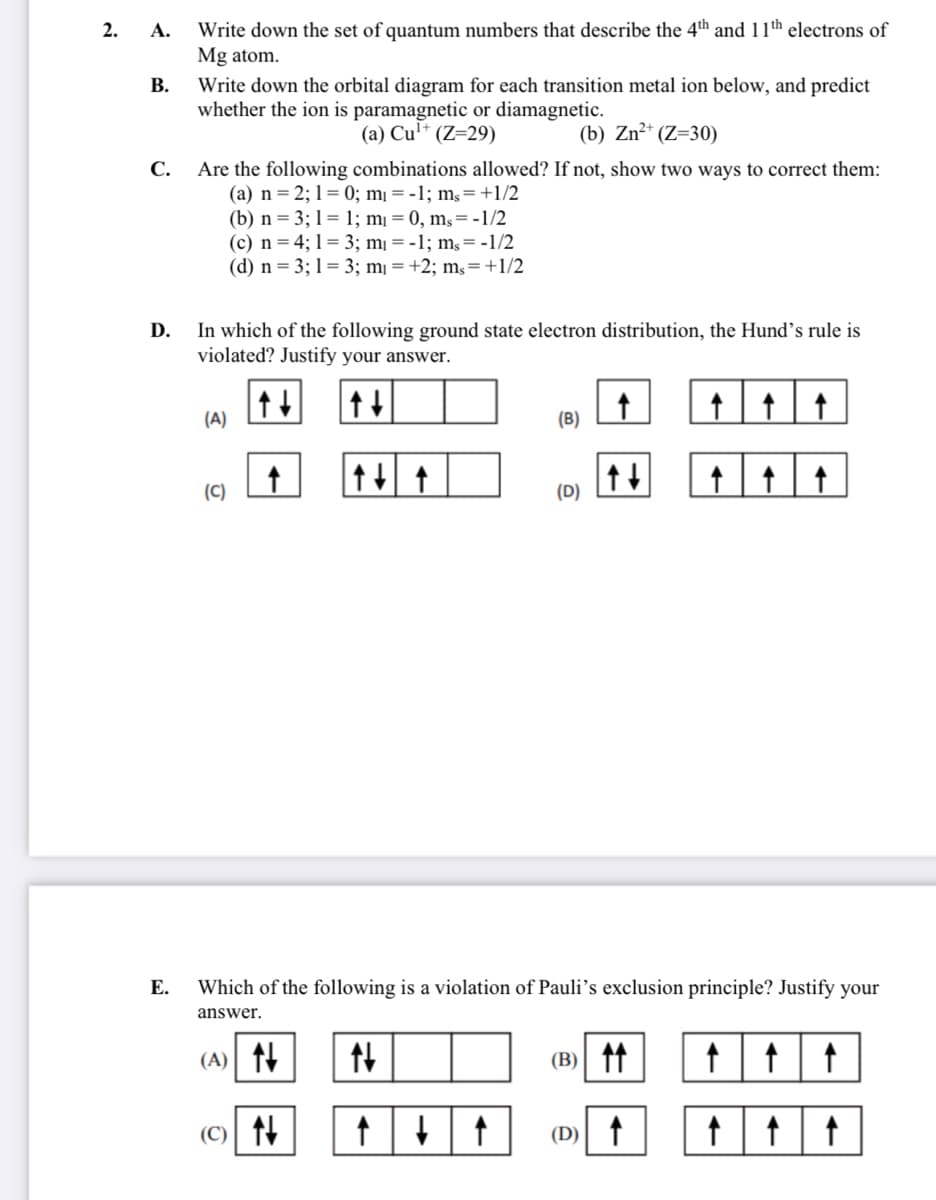Write down the set of quantum numbers that describe the 4th and 11th electrons of Mg atom. 2. A. В. Write down the orbital diagram for each transition metal ion below, and predict whether the ion is paramagnetic or diamagnetic. (a) Cu'* (Z=29) (b) Zn2* (Z=30) С. Are the following combinations allowed? If not, show two ways to correct them: (a) n = 2; 1= 0; m¡ = -1; ms=+1/2 (b) n = 3; 1= 1; m = 0, mş= -1/2 (c) n = 4; 1= 3; mị = -1; ms= -1/2 (d) n = 3; 1= 3; m = +2; mş=+1/2
Write down the set of quantum numbers that describe the 4th and 11th electrons of Mg atom. 2. A. В. Write down the orbital diagram for each transition metal ion below, and predict whether the ion is paramagnetic or diamagnetic. (a) Cu'* (Z=29) (b) Zn2* (Z=30) С. Are the following combinations allowed? If not, show two ways to correct them: (a) n = 2; 1= 0; m¡ = -1; ms=+1/2 (b) n = 3; 1= 1; m = 0, mş= -1/2 (c) n = 4; 1= 3; mị = -1; ms= -1/2 (d) n = 3; 1= 3; m = +2; mş=+1/2
Chemistry: An Atoms First Approach
2nd Edition
ISBN:9781305079243
Author:Steven S. Zumdahl, Susan A. Zumdahl
Publisher:Steven S. Zumdahl, Susan A. Zumdahl
Chapter20: Transition Metals And Coordination Chemistry
Section: Chapter Questions
Problem 1RQ: What two first-row transition metals have unexpected electron configurations? A statement in the...
Related questions
Concept explainers
Atomic Structure
The basic structure of an atom is defined as the component-level of atomic structure of an atom. Precisely speaking an atom consists of three major subatomic particles which are protons, neutrons, and electrons. Many theories have been stated for explaining the structure of an atom.
Shape of the D Orbital
Shapes of orbitals are an approximate representation of boundaries in space for finding electrons occupied in that respective orbital. D orbitals are known to have a clover leaf shape or dumbbell inside where electrons can be found.
Question

Transcribed Image Text:Write down the set of quantum numbers that describe the 4th and 11th electrons of
Mg atom.
2. А.
В.
Write down the orbital diagram for each transition metal ion below, and predict
whether the ion is paramagnetic or diamagnetic.
(a) Cul* (Z=29)
(b) Zn²* (Z=30)
С.
Are the following combinations allowed? If not, show two ways to correct them:
(a) n = 2; 1 = 0; mị = -1; ms= +1/2
(b) n = 3; 1= 1; mị = 0, mş=-1/2
(c) n= 4; 1= 3; mị = -1; ms= -1/2
(d) n = 3; 1= 3; mị = +2; mş=+1/2
In which of the following ground state electron distribution, the Hund's rule is
violated? Justify your answer.
D.
(A)
(B)
(C)
(D)
Е.
Which of the following is a violation of Pauli's exclusion principle? Justify your
answer.
(A) 11
(B) tt
(C) 14
(D) f
Expert Solution
This question has been solved!
Explore an expertly crafted, step-by-step solution for a thorough understanding of key concepts.
Step by step
Solved in 2 steps with 2 images

Knowledge Booster
Learn more about
Need a deep-dive on the concept behind this application? Look no further. Learn more about this topic, chemistry and related others by exploring similar questions and additional content below.Recommended textbooks for you

Chemistry: An Atoms First Approach
Chemistry
ISBN:
9781305079243
Author:
Steven S. Zumdahl, Susan A. Zumdahl
Publisher:
Cengage Learning


Chemistry
Chemistry
ISBN:
9781305957404
Author:
Steven S. Zumdahl, Susan A. Zumdahl, Donald J. DeCoste
Publisher:
Cengage Learning

Chemistry: An Atoms First Approach
Chemistry
ISBN:
9781305079243
Author:
Steven S. Zumdahl, Susan A. Zumdahl
Publisher:
Cengage Learning


Chemistry
Chemistry
ISBN:
9781305957404
Author:
Steven S. Zumdahl, Susan A. Zumdahl, Donald J. DeCoste
Publisher:
Cengage Learning

Chemistry: Principles and Practice
Chemistry
ISBN:
9780534420123
Author:
Daniel L. Reger, Scott R. Goode, David W. Ball, Edward Mercer
Publisher:
Cengage Learning

Chemistry: The Molecular Science
Chemistry
ISBN:
9781285199047
Author:
John W. Moore, Conrad L. Stanitski
Publisher:
Cengage Learning

Chemistry: Principles and Reactions
Chemistry
ISBN:
9781305079373
Author:
William L. Masterton, Cecile N. Hurley
Publisher:
Cengage Learning